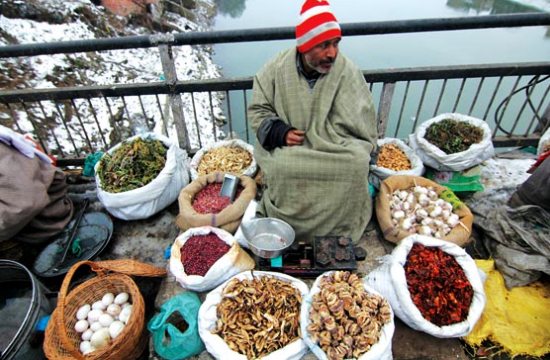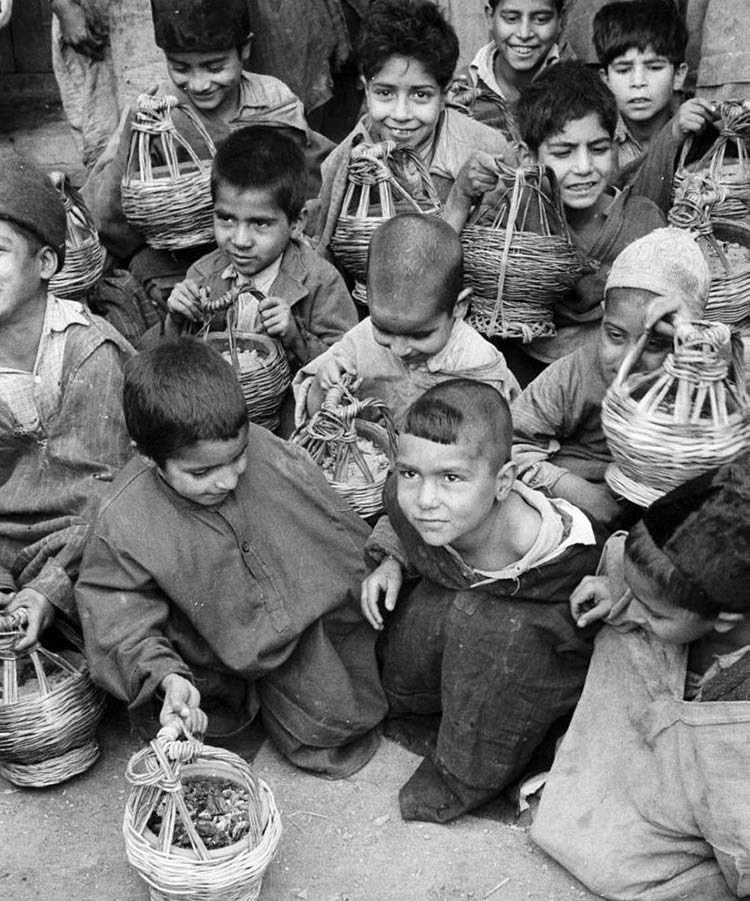Winters have evolved their own unique lifestyle in Kashmir. Many things have changed over years, but some things from yesteryear’s are still there. Aliya Bashir takes a look at the winter life in Kashmir.

Mugil Ded, 80, woke up early on Friday to take a bath and get ready to attend a ring ceremony of her relative. When she came out of the bathroom her kin draped a blanket over her, gave her a hot water bottle, Kangri, blower and a cup of hot kehwa to get some warmth. But, all these things could not make her comfortable.
“In our childhood, having a bath in chillai-kalan was a reverie. We were having a single tap in our mohalla which used to get frozen in the chill. We used to keep bonfire near the tap. We used to sprinkle our face with water which was enough at that time,” she says. “Today there is hardly any difference between winter and summer.”
 As her grand children were having a breakfast of corn-flakes and buttered bread, she became nostalgic about her childhood and remembers how they used to have khichdi (a spicy mixture of rice, cereals and meat), water- chestnuts and a variety of such eatables.
As her grand children were having a breakfast of corn-flakes and buttered bread, she became nostalgic about her childhood and remembers how they used to have khichdi (a spicy mixture of rice, cereals and meat), water- chestnuts and a variety of such eatables.
“I still remember a vendor who used to sell roasted corn and I loved it. If we used to visit some relative they used to have shab-daig (a recipe made of meat, turnip and beans), fish and dried vegetables. The specialties were exclusively meant for winter unlike today when everything is available throughout the year,” she says. “We used to make ice cream of snow by adding sugar and milk to it. I used to visit Jamia Masjid in old city to break icicles. We had a lot of fun unlike our grand-children…those were good times.”
Mugil Ded says that due to heavy snowfall the movement outside the houses was not an easy affair and they used to wear khraws (wooden sandals) which were made exclusively for winter. The Islamabad made sandals with decorative designs for girls were in fashion.
“In summers we used to dig turnip and radish beneath the earth under some roof top and in winter we used to take them out for cooking. These vegetables used to be very fresh and tasty. One used to relish such rare things available in winter,” she says.
This was the glimpse of winter in Kashmir 60 years back, through the eyes of Mugil Ded. It was altogether a different world. Heavy snowfall was a norm and at times seven feet snow will accumulate on the streets, no power, no hi-tech heating gadgets.

In the past, the winters seemed to stretch up to six months. The dip in temperature used to put a halt on every activity with heavy snowfall leading to blockade of main roads.
“Winter in Kashmir was like a war. We used to gear ourselves up in all the possible ways to face it,” says Zareef Ahmed Zareef, noted Kashmiri poet and writer. “There is a hell of difference in the winter of our childhood and now.”
Gulzar Ahmed, a businessman says, “Our increasing dependence on electricity and other modern gadgets is ruining us. Traditional practices help us to fight harsh winters better.”
Winter is a perfect season for getting together with friends and family around a relaxed, well-prepared meal.
The three parts of the harshest 70 days of winter in Kashmir are traditionally called Chillai Kalaan, Chilla Khurud and Chilla Baccha. Chillai Kalaan stretches over 40 days starting December 22 and is considered to be the coldest and harshest among the three chillas. Chilla Khurd, spread over 20 days, follows Chillai kalan and is less severe than it. At last comes Chilla Baccha which lasts for 10 days and ends in first week of March.
In past, people used to eagerly wait for heavy snowfall, especially during Chillai Kalaan, to end spell of dry cold. However, in the recent years snowfall has been scarce. “I remember the days in my childhood, when we had witnessed four to six feet snow through which we would walk to reach the markets for buying groceries,” says Mohammad Ghani, a resident of Srinagar.
In comparison to present dependence on electricity, Zareef says that in past minimal electricity was used during winters – not more than two bulbs would be used in a house which would cost of one rupee for a month. “In winters we used to have only two rooms in use. Only two bulbs used to be available in kitchen and another room attached to it,” he says. “In villages kerosene lanterns were in vogue besides small earthen lamps.”
Despite changes in life style and tastes Hokh-suen (dried vegetables) still finds a place in many kitchens in Kashmir. Due to the scarcity of fresh vegetables during the winter, vegetables would be dried during summer months and stocked for the winters.
“There is a lot of demand for the Hokh-suen. We have lot of customers who take these vegetables to outside state and also to foreign countries. There is also a good demand for dried fish,” says Ghulam Mohammad Khan who sells dried-vegetables in Dalal-Mohalla in Srinagar.
The dried vegetables common in Kashmir are of gourds, tomatoes, turnip, brinjal, fenugreek and turnip leaves.
Historian Fida Mohammad Hasnain says, “In past people used to prepare themselves for the harsh winter. In summers, Kashmiris used to collect essentials like rice, vegetables, pulses and salt. Today, even Hokh-suen items are available in markets and people hardly dry the food items at home.”
Hameeda, a housewife who dries vegetable every summer for use in the winters says, “Kashmiris have mastered the art of drying vegetables since ages.” She prefers her home made Hokh-suen.
“We (kashmiris) have the strong belief that Hokh-suen provides us warmth and helps to get rid of cough and cold. These are very appetizing besides these can be preserved for a longer time,” she says. “We also had Kashmiri spice cake (vaer), an aromatic appetizer.”
“The consumption of meat was also very little. The butcher used to slaughter hardly one sheep in a week in a locality,” says Hameeda’s mother-in-law. “Those days every activity used to get affected due to the cold and people used to look for alternatives to feed their family. People were mostly poor. Children were given eggs, carrots and potatoes which were roasted in Kangri (portable fire pot). No junk food was available that time.”
During winters, a culinary dish popular in Kashmir is harisa – boneless mutton dish eaten in the morning. Harisa has retained its popularity with Kashmiris, even in modern times. People flock to Harisa shops early in the morning and almost all localities in urban centres have such shops which operate in the winters only. It takes lot of time and effort to make Harisa but nowadays people also prepare it at their homes.
“The rush of our customers has gone down as compared to the past as people prefer to make harisa at home. They enjoy cooking themselves. Most of the customers in downtown shifted to suburban colonies and they could not come to our shops early in the mornings in old city,” says Abdul Rashid Bhat, a harisa-seller in Aali-Kadal, Srinagar.
Every household had different birds to rear at home especially hen and they used to sell their eggs to earn some money during winters.
Below the verandas, there were hen pens in which chicken, duck, swan would be reared. “Kids used to steal those eggs and do all the mischievous activities in absence of their parents,” says Nisar Ahmed Sofi, a shopkeeper in old city.
Zareef says Kashmir was less dependent on imported food items those days. The Jammu-Srinagar highway used to be often closed in the month of January and February due to snowfall. “We were self-sufficient. Only salt, tea and textiles used to be imported. Today we even import vegetables and bakery,” says Zareef. Even the fabric for winter used to be self-made in weavers’ Mohalla in Khanyar.
 Academician and columnist Prof G R Malik says, “We used to have a very long spell of snowfall. There was a natural social bonding in our culture. We used to visit each other’s home and spend good time together and read stories and discuss other issues. But today people are so much busy that one hardly gets time to visit friends and relatives.”
Academician and columnist Prof G R Malik says, “We used to have a very long spell of snowfall. There was a natural social bonding in our culture. We used to visit each other’s home and spend good time together and read stories and discuss other issues. But today people are so much busy that one hardly gets time to visit friends and relatives.”
“I miss the snowfall and icicles of my childhood. Due to sub zero temperatures roof tops used to freeze, we used to break the ice in the morning. We would enjoy it,” he says.
Malik says that due to the availability of television, radio and internet in every house, people have been confined to their homes.

The use of Kangri is incomplete without the ‘Pheran’ (a loose-fitting woolen gown). Charcoal is used in the Kangri which is used inside the Pheran to keep the body warm. “It is a poor man’s weapon to fight chill. It has become an integral part of our life,” says Zamrooda, an elderly woman carrying Kangri underneath her tilla-embroidered pheran.
Malik says that many things associated with the winter life of Kashmir have been lost as modern gadgets and other luxuries have made their way into popular culture. “Modern gadgetry has replaced the traditional things in Kashmir. Luckily Kangri continues to be an integral part of our culture though nobody can say how long it will remain so.”
Another important feature of the rich tradition of Kashmir is Samovar. It is traditionally used to prepare tea especially Noon-Chai (salted kashmiri tea) and Kehwa. However the use of Somavar has restricted to gatherings and functions.
The charm of the winters has been diminished primarily due to the decrease in snowfall besides the accessibility to modern gadgets has impacted traditional way of life in Kashmir.















